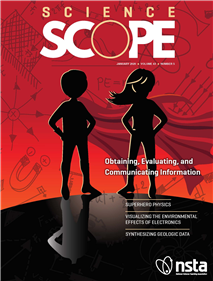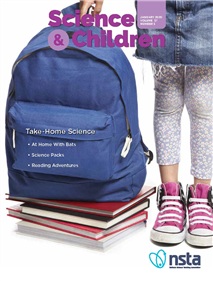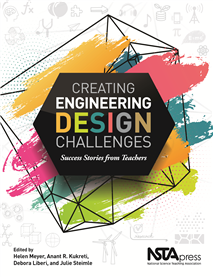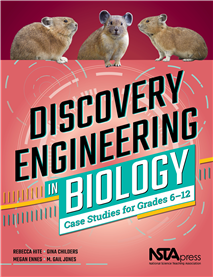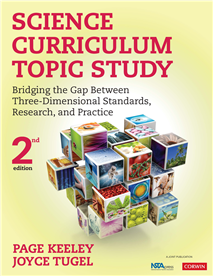All Resources
Journal
The Science Teacher—January 2020
Volume 87, Number 5 Fake news. Pseudoscience. Bad Science. Never before has so much information, both good and bad, been available to us. If our students graduate knowing the steps of the Krebs cycle but cannot re...
Journal
Volume 43, Number 5 Over the past decade, the proliferation of superhero movies has exploded. Although the heroes fight crime and uphold the law, few abide by the laws of physics. To tap into students’ interests, students were presented with...
Journal
Science and Children—January 2020
Volume 57, Number 5 This month we take a look at ideas for exploring science and engineering at home. Helping families create a culture of curiosity and wonder with thoughtful suggestions for explorations, connections to literature, ideas for ex...
Journal
Journal of College Science Teaching—January/February 2020
Volume 49, No. 3, January/February 2020 ...
Journal Article
Design Elements From a Rural, Multi-Organization Collaborative
On a Saturday afternoon last May in Hamilton, Montana, 150 people gathered in a college gymnasium for the Bitterroot Maker Fair. At tables around the room, student educators from the University of Montana (UM) spectrUM Discovery Area guided K–12 ...
By Beth Covitt, Vic Mortimer, Nick Wethington, and Nathalie Wolfram
Journal Article
Middle school is a critical time for fostering girls’ interest in science, as it is during these years that girls begin to identify with their strengths and weaknesses and start to decide what kind of person to be (Allen and Eisenhart 2017; Carlo...
By Alicia Santiago, Kristin Pederson, and Rita Karl
Journal Article
STEM (science, technology, engineering, and mathematics) mindset is critical to youths’ ongoing participation in STEM, as well as their functioning in today’s technology-rich world (e.g., Murphy 2019). This is true for all students, but it is e...
By Jeanna R. Wieselmann
Virtual Conference
Archive: The Crosscutting Concepts as Lenses to Explore Phenomena, February 8, 2020
Crosscutting concepts are sometimes the neglected dimension of the NGSS and other standards based on the Framework for K-12 Science Education. But crosscutting concepts can provide students a useful lens for making sense of phenomena. They include pa...
Virtual Conference
Archive: Connecting In-school and Out-of-school STEM Learning and Teaching, December 7, 2019
Blended STEM learning experiences that connect in-school and out-of-school learning are a key recommendation in the recently released America’s Strategy for STEM Education: Creative, blended educational opportunities that combine elements from t...
Virtual Conference
NSTA Virtual Conference: The Crosscutting Concepts as Lenses to Explore Phenomena, February 8, 2020
Crosscutting concepts are sometimes the neglected dimension of the NGSS and other standards based on the Framework for K-12 Science Education. But crosscutting concepts can provide students a useful lens for making sense of phenomena. They include pa...
eBook
Creating Engineering Design Challenges: Success Stories From Teachers (e-book)
If you’ve ever wished for advice you can trust on how to make science and math more relevant to your middle or high school students, Creating Engineering Design Challenges is the book for you. At its core are 13 units grounded in challenge-based le...
eBook
Discovery Engineering in Biology: Case Studies for Grades 6–12 (e-book)
Show your students how amazing it can be to just “see what will happen” when they blend biology, engineering, and serendipity. Focusing on innovations sparked by accidental or unexpected observations, the case studies in this resource are a livel...
NSTA Press Book
Scientific literacy for all students requires a deep understanding of the three dimensions of science education: disciplinary content, scientific and engineering practices, and crosscutting concepts. If you actively engage students in using and apply...
By Page Keeley, Joyce Tugel
Book Chapter
Chapters 1–3 provide background information and introduce the particular engineering design process (EDP) used in the Cincinnati Engineering Enhanced Math and Science (CEEMS) program, as well as how the design challenge unit framework connects with...
Book Chapter
Design Challenge Units and Research on Learning
Chapters 1–3 provide background information and introduce the particular engineering design process (EDP) used in the Cincinnati Engineering Enhanced Math and Science (CEEMS) program, as well as how the design challenge unit framework connects with...
Book Chapter
Defining and Using Our Design Challenge Units
Chapters 1–3 provide background information and introduce the particular engineering design process (EDP) used in the Cincinnati Engineering Enhanced Math and Science (CEEMS) program, as well as how the design challenge unit framework connects with...
Book Chapter
Setting the Stage: Create Hooks to Secure Student Buy-In
Chapters 4–7 contain sections written by individual secondary math and science teachers (grades 6-12) who focus on different aspects of implementing design challenge units. In this chapter, the teachers’ stories capture the excitement of engaging...
Book Chapter
Focusing on the Engineering Design Process
Chapters 4–7 contain sections written by individual secondary math and science teachers (grades 6-12) who focus on different aspects of implementing design challenge units. In this chapter, the three teachers detail the teaching strategies they use...
Book Chapter
Integrating Assessment Into Design Challenge Units
Chapters 4–7 contain sections written by individual secondary math and science teachers (grades 6-12) who focus on different aspects of implementing design challenge units. In this chapter, the three teachers identify the appropriate content that w...
Book Chapter
Developing 21st-Century Skills With Design Challenge Units
Chapters 4–7 contain sections written by individual secondary math and science teachers (grades 6-12) who focus on different aspects of implementing design challenge units. In this chapter, the teachers recognize the needs of students and develop i...
Book Chapter
Getting Started With Design Challenge Units
This chapter demonstrates how to modify another teacher’s design challenge for your own classroom and how to reflect on and improve your own units after implementation. It also shares resources for finding design challenge unit ideas, finding techn...
NSTA Press Book
Creating Engineering Design Challenges: Success Stories From Teachers
If you’ve ever wished for advice you can trust on how to make science and math more relevant to your middle or high school students, Creating Engineering Design Challenges is the book for you. At its core are 13 units grounded in challenge-based le...
NSTA Press Book
Matter and Energy for Growth and Activity, Teacher Edition
How do our bodies manage to heal wounds, build the stamina to run marathons, and give us the energy—even while we’re sleeping—to keep us alive and functioning? Matter and Energy for Growth and Activity prompts high school students to explore fa...
By AAAS/Project 2061
NSTA Press Book
Matter and Energy for Growth and Activity, Student Edition
How do our bodies manage to heal wounds, build the stamina to run marathons, and give us the energy—even while we’re sleeping—to keep us alive and functioning? Matter and Energy for Growth and Activity prompts high school students to explore fa...
By AAAS/Project 2061
NSTA Press Book
Discovery Engineering in Biology: Case Studies for Grades 6–12
Show your students how amazing it can be to just “see what will happen” when they blend biology, engineering, and serendipity. Focusing on innovations sparked by accidental or unexpected observations, the case studies in this resource are a livel...
By Rebecca Hite, Gina Childers, Megan Ennes, M. Gail Jones
Book Chapter
This chapter presents a case study on Controlling Mosquitoes to Stem Malaria Infection using the discovery engineering process. In the lesson, students learn how scientists discovered the way in which malaria spreads. Students review malaria infecti...
Book Chapter
This chapter presents a case study on John Snow’s Research Into the Cause and Spread of Cholera using the discovery engineering process. In the lesson, students explore the 1854 cholera outbreak in London and analyze the work done by Dr. John Snow...
Book Chapter
This chapter presents a case study on thalidomide Hidden Tragedy and Second Chances using the discovery engineering process. In the lesson, students explore the history of thalidomide, a drug with side effects that caused serious congenital deformi...
Book Chapter
This chapter presents a case study on Using Biological Mechanisms to Treat Diseases and Disorders using the discovery engineering process. In this lesson, students read a case study about scientists who discovered a way to use snake venom in the diag...
Book Chapter
This chapter presents a case study on The Discovery of Dangerous Drug Interactions using the discovery engineering process. In this lesson, students read a case study on the discovery of the adverse effect of combining grapefruit with certain medi...
Book Chapter
This chapter presents a case study on The Accidental Discovery of the Pacemaker using the discovery engineering process. In this lesson, students explore the development of the pacemaker and discover that some heart conditions are controlled with ...
Book Chapter
This chapter presents a case study on Treating Anaphylaxis Due to Allergies using the discovery engineering process. In this lesson, students explore the discovery of anaphylaxis response due to overexposure of allergens. The discovery of this phenom...




